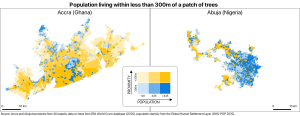Availability is not proximity
Green spaces offer essential ecosystem services to cities, one of which is enhancing resilience to heat waves, which is critical for African urban agglomerations. Africa is projected to warm 1.5C faster than the global average. Cities in West Africa will likely reach dangerous heat 145 to 196 days per year in the late century, which carries with it a myriad of health risks. Trees are a nature-based solution to heatwave because of their cooling effects around such patches by up to 2 to 3C, in some instances. Yet, as African agglomerations rapidly urbanise, the competition for land means these spaces are often lost.

Some ecosystem services – like pollution regulation – depend on the % availability of trees but this cannot fully capture the role trees can play as a solution to heat waves. This map shows the population living within 300m of 1-hectare patches of trees or larger in Abuja and Accra. These two cities have the same % available green space – 20% of their urban footprint. But only 16% of the population of Accra is located within 300 meters and is likely to benefit from its cooling effects. Large swaths of Accra are covered in dark yellow, meaning these areas are extremely vulnerable to heat waves in the future. In contrast, 51% of the population in Abuja lives within 300 meters. Dark yellow areas of these cities will need additional interventions, to cope with heat waves in the future, either tree planting or other cooling solutions, especially in Accra. Above all, Accra and Abuja illustrate that availability does not mean that people live in close proximity to such spaces. Decision-makers will have to consider the distribution of green space throughout the agglomeration to realise the complete set of ecosystem services these spaces can provide.

